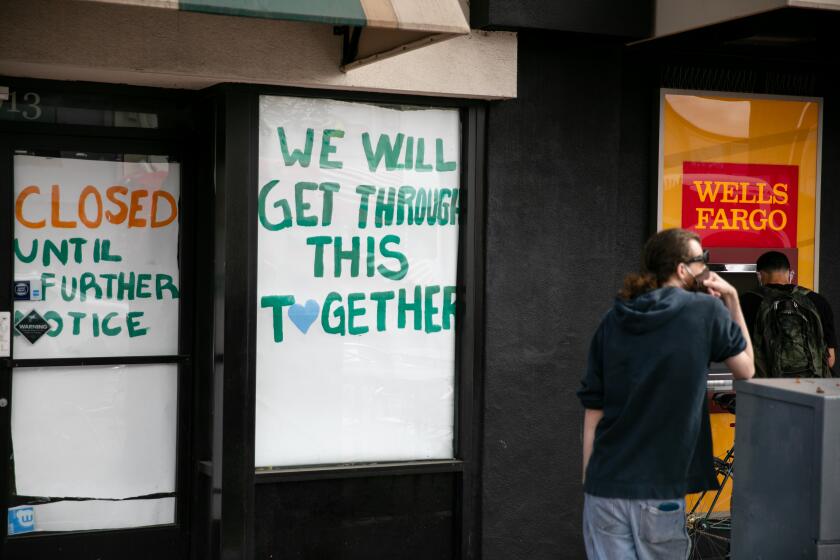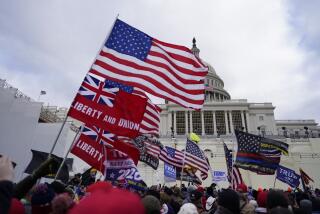Column: Trump’s defeat was supposed to launch a new progressive era, so what happened?

Democrat Joe Biden appears to have ousted Donald Trump from the White House, yet for many Democrats and progressives the results of the election have produced mostly disillusionment, even despair.
The reason isn’t hard to decipher. They expected the end of the Trump era to be marked by a “blue wave,” a surge of progressive political power that would sweep away not only Trump but right-wing obstructionism in the Senate and, in time, even the Supreme Court.
But the wave isn’t visible in the results, so what’s consumed the left is pessimism and gloom.
The model for this take comes from the liberal writer Eric Levitz of New York Magazine, who pronounced the election “a nigh-catastrophic setback for progressive politics in the United States.”
Levitz declared the Senate lost to Democrats for at least a decade to come and even cast doubt on the party’s ability to hold on to the White House in 2024. All this before all the votes have been counted in 2020.
History has some advice for the despairing: Settle down and take a deep breath. Things aren’t nearly that bad.
You don’t need a message that will only appeal to the Rust Belt or only appeal to the Sun Belt. You can run on a broad message that has appeal ... to those voters in Southern states, to younger voters, to non-whites all over the country.
— Progressive political analyst Ruy Teixeira
A couple of fundamental points need to be made at the outset. One is that a progressive trend in American politics has been building for years; evidence of it was visible in many down-ballot contests on election day and obscured by exotic conditions in others. More on that in a moment.
Another is that it’s foolish to be defeated by one’s own exaggerated expectations. Political “waves” don’t happen all that frequently, and when they do, they’re often evanescent, in part because they can provoke equal and opposite reaction.
Henry A. Wallace, FDR’s vice president, foresaw the fascism of Trump.
It may be better for progressivism to continue to infuse itself into the body politic in stages, rather than all at once.
The notion that American politics moves in waves is an artifact of analytical hindsight. Jack Balkin, a constitutional law scholar at Yale, recently cited his colleague Stephen Skowronek’s categorization of political cycles for a Washington Post op-ed.
These eras are the Federalist (1789-1800), Jeffersonian (1800-1828), Jacksonian (1828-1860), Republican (1860-1932), New Deal-Civil Rights (1932-1980) and Reagan (1980-the present).
“In each political era,” Balkin observes, “a new dominant party arises, forms a winning coalition, promotes its interests and ideology, and eventually decays and collapses, often the victim of its own past success.”
Reagan Republicanism has run out its string, Balkin writes, setting the stage for “a new regime with a new dominant coalition and a new dominant party, most likely the Democrats.”
Yet it’s important to note that changes of political eras usually don’t occur so abruptly — or at least that such changes are often visible only in a rearview mirror.
One might be inclined to think of the New Deal-Civil Rights era, for instance, as nearly a half-century of unbroken progressivism, but it didn’t appear full-blown with the 1932 election and took decades to fully play out. As I’ve written, the New Deal itself was a mélange of liberal and conservative policies under Franklin Roosevelt’s leadership.
The second item on FDR’s legislative list during his vaunted first Hundred Days, after closing the banks and arranging for their reopening under sturdier financial circumstances, was the Economy Act, which slashed the pay of federal employees and cut veterans’ benefits, all in the name of balancing the federal budget.
Trump’s economic vision looks to a long-gone America; Biden’s to the next stage.
During the 1932 presidential campaign, Marriner Eccles, the Utah banker who would help FDR remake the Federal Reserve System, was perplexed by the spectacle of the conservative Herbert Hoover touting the dynamism of his public works spending while the ostensibly progressive Roosevelt castigated him for his spendthrift ways.
“The campaign speeches,” Eccles reflected, “often read like a giant misprint, in which Roosevelt and Hoover speak each other’s lines.”
The New Deal often institutionalized the racism in federal programs, and FDR resisted to the last Black activists’ pleas for an anti-lynching law. Roosevelt almost torpedoed Social Security’s old-age program on the very eve of its enactment in 1935 (his priority for the law was an unemployment relief program).
The progressive rethinking of the federal government’s relationship with the people that began with Social Security didn’t reach its full flowering until three decades later, with Lyndon Johnson’s creation of Medicare and Medicaid in 1965. In other words, these things take time.
Another problem with shoehorning political history into discrete eras is that political parties are rarely monoliths.
The Republicans of Skowronek’s 1860-1932 period encompassed the stolid pro-business politics of William McKinley and the progressivism of McKinley’s vice president and successor, Theodore Roosevelt — who would eventually splinter from the GOP by forming the Progressive or “Bull Moose” Party to run for President in 1912. The progressive cause was carried on by President Woodrow Wilson, a Democrat, in 1913-1921.
After the 1932 election, FDR wavered between liberal and conservative policies in part because some of his strongest progressive supporters were Republicans and some of his most powerful critics were Southern Democrats, whom he could not afford to alienate with civil rights initiatives.
Contrary to Trump’s claims, history shows the economy and stock market do better under Democrats than Republicans
This year’s election reminds us that not all states or regions are as ideologically monochromatic as they appear on the surface. Florida voters went for Trump, but also passed a $15 minimum wage law. Only two years ago, moreover, Floridians opted to restore voting rights to felons who had completed their sentences.
That would have added as many as 800,000 voters to the rolls had not Republican Gov. Ron DeSantis and the Republican-controlled legislature not worked hard to undermine the law by imposing fees and conditions to the restoration.
Other apparent retrenchments from progressive trends may have other explanations than ideology.
Take California’s Proposition 22, which seemed to reverse the progressive trend toward better workplace benefits and protections by allowing ride-hailing companies such as Uber and Lyft to continue treating their drivers as independent contractors with substandard rights.
A key to the initiative’s passage was plainly the more than $205 million spent by those companies and other “gig” employers to draft and promote the measure.
California Democrats may have given back a couple of the congressional seats they wrested from the GOP in 2018 (as we write, the outcome is still unclear), but they may also have solidified their control of the state Senate by adding some seats to their preexisting supermajority.
Voters also approved a progressive proposal to restore voting rights to parolees, while rejecting a measure that would have increased penalties for minor offenses.
The trend toward a more progressive American electorate has been developing over the long term. Democratic presidential candidates have won the popular vote in seven of the last eight elections, from Bill Clinton’s first victory in 1992 through Biden’s win.
Wall Street Democrats’ fear of Elizabeth Warren reminds us that they opposed the New Deal too.
In two of those elections, however, the popular vote loser became president — George W. Bush in 2000 and Trump in 2016 — due to the peculiarities of the electoral college (and in Bush’s case, the meddling of the Supreme Court).
Many progressives have been wringing their hands over the thought that some 69 million Americans could have cast their votes for a candidate as manifestly unfit for reelection as Donald Trump. Here it’s also worth examining the record. Over the last 200 years of American history, the presidential vote has almost never broken down by more than about 60-40.
That’s true even in elections viewed as landslides. The largest percentage of the popular vote secured by a winning candidate since 1820 belonged to Lyndon Johnson in 1964, when he trounced Barry Goldwater by winning 44 states; even then, his share of the popular vote was only 61.05%
A similar story unfolded when Richard Nixon lost only Massachusetts and the District of Columbia to George McGovern in 1972 but collected only 60.67% of the popular vote and in FDR’s commanding victories over Herbert Hoover in 1932 (FDR won 42 out of 48 states, and 57.41% of the popular vote) and over Alf Landon in 1936 (losing only Maine and Vermont to Landon yet 60.8% of the popular vote).
In other words, with few exceptions presidential elections have been fought for voters in the no-man’s-land of the middle 20 percentage points, no matter how plausible or implausible any candidate has been.
The 2020 contest, judging from the current numbers, was no exception: Biden’s record-setting popular vote, which is approaching 72.5 million, still amounts to only about 50.4% of the total votes cast.
Over the last couple of decades progressive projects have materially advanced in American politics. The nation has embraced gay rights including same-sex marriage, the legalization of marijuana and moved toward universal health coverage. Immigration policies were becoming more liberal.
None of this happened without significant pushback from reactionary elements in all three branches of government and at all governmental levels. As has been often observed, the path to justice is not a straight one.
If there’s a silver lining in the blue wave that never came, it may be that the outcome will prompt Democrats to take stock of their approach to building a lasting political edifice. That’s the view of Ruy Teixeira, whose 2002 book “The Emerging Democratic Majority,” co-written with John Judis, examined the demographic trends underlying Democratic power.
Teixeira’s thesis, as he told Greg Sargent of the Washington Post before election day, was that a Democratic coalition uniting non-whites, professionals and people who live in cities and suburbs “could only be dominant and stable if it managed to retain a substantial share of the white working class.”
These are people who “haven’t been doing well for decades,” Teixeira says. “Their communities have suffered declines, jobs problems, healthcare problems. Democrats have to speak to these people.... You don’t need a message that will only appeal to the Rust Belt or only appeal to the Sun Belt. You can run on a broad message that has appeal not only to persuadable members of the white working class in the Northern-tier swing states, but also has appeal to those voters in Southern states, to younger voters, to non-whites all over the country.”
For Democrats, this is still a work in progress. There has been progress; what the election tells us is that the destination hasn’t been reached, just yet.









